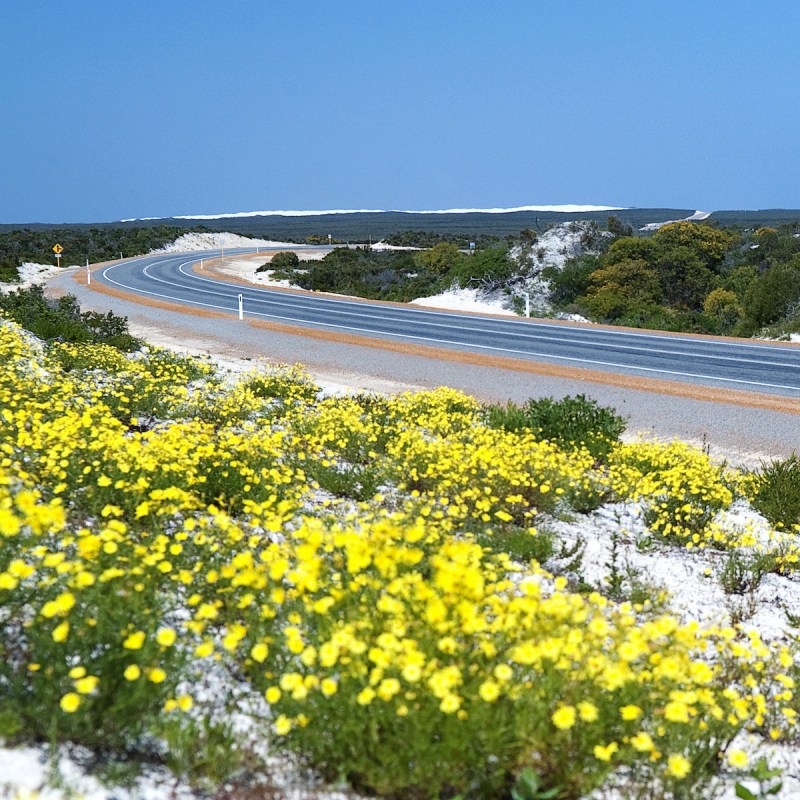
As Lou Rawls sang: “It’s spring again / I can hear the birds sing again / See the flowers start to bud / See young people fall in love.”
Videos by TravelAwaits
Travel is like spring, invigorating us with a zest for life. Spring is in March, April, and May in the U.S. and UK. But if you visit Australia, experience a repeat performance as spring is from September through November.
Spring in Australia will surprise and delight you with landscapes awash with blooms. Anthophiles — people drawn to flowers — will be in heaven! Encounter native flowers you may never have seen before. As the early settlers cultivated European plants to remind them of the Old Country, there are also some magnificent, traditional gardens.

1. Jacaranda Trails
Sydney, Grafton, And Brisbane
Jacaranda trees have clusters of purple blooms that fall like violet rain draping the landscape in a regal cloak. They thrive in Australia’s tropical and subtropical regions.
In Sydney, jacarandas form a dramatic foreground to the Sydney Harbour Bridge and Sydney Opera House. Wendy Whiteley’s Secret Garden in Lavender Bay has a spectacular view of the harbor foreshore dotted with purple plumes. They also flourish in suburbs like Kirribilli, Greenwich, Waverton, Hunters Hill, and Woolwich. Follow Sydney’s Jacaranda Trail to spot the purple.
Brisbane City Botanic Gardens is where Australia’s first grown Jacaranda tree was planted in 1864 with seeds given to the curator of the gardens, Walter Hill, by a visiting South American sea captain.
Now Jacarandas are everywhere. At the University of Queensland’s St. Lucia campus, the students call the bloom “purple panic” as flowering coincides with their exams. At New Farm Park, by the Brisbane River, 140 trees burst into bloom every October in a dazzling display. Here’s where to paint the town purple from Brisbane to the Gold Coast.
Purple power lures crowds to historic Grafton, 372 miles north of Sydney. The Grafton Jacaranda Festival happens every October through to November. There are more than 1,700 Jacaranda trees celebrated with street parades and themed floats, markets, live performances, and fireworks. The first festival was first held in 1934 as the rural town was struggling out of the Great Depression. Today, the Jacaranda Festival is the longest-running floral festival in Australia. Stroll, ride a bike, or drive a car through the color purple.

2. Canberra’s Floriade
Canberra
There’s no better time to visit Canberra, Australia’s capital, than during the Floriade, the largest flower festival in the Southern Hemisphere, with over a million flowers on display. It is centrally located on the shores of Lake Burley Griffin, waves of magenta, gold, mauve, and cobalt ripple across the grounds in a sea of color.
Known as “Australia’s Celebration of Spring,” the many different cultural events attract thousands of locals and tourists.
The Floriade started in 1988. The first theme was multiculturalism, with displays based on the Netherland’s world-famous Keukenhof garden. Each year, the Floriade garden beds reflect a different theme. The 2021 theme was “The Future of Flowers,” exploring the possibilities of tomorrow.
The themes are expressed in the garden beds for pictures if seen from above. To fully appreciate their designs, ride the Ferris wheel on site. Or, if weather conditions permit, see the Floriade gardens from above from a hot air balloon.
Canberra was a purpose-built capital designed by the American architect and landscape artist Walter Burley Griffin. His pattern of circles and spokes is also best appreciated from above.
Pro Tip: NightFest Floriade offers cutting-edge light installations, markets, live music, comedians, and DJs and is a paid ticketed event. But during the day, like most Canberra attractions, the Floriade Festival is a free event.

3. Wildflower Trails
Western Australia
Canberra’s Floriade attracts thousands of people, but there are many places in Australia where dramatic banks of flowers are in the wild and seen in more personal communion with nature.
Sometimes called the greatest flower show on Earth, Western Australia is home to over 12,000 species of wildflowers — 60 percent of which can’t be found anywhere else on Earth, resulting in magnificent wildflower trails. Some highlights include Red-and-Green Kangaroo Paw, pink coneflower, Bull Banksia, Holly-leaved Banksias, Hakea Emu Tree, Winged Boronia, and Green Spider Orchid.
Seeing brilliant wildflowers color the outback landscape is a unique experience. People travel from the eastern states just to see them.
Take the road trip adventure of a lifetime staying in outback stations, some of them as big as small European countries. See WA Visitor’s Centre for more details.
There are also guided tours from half-day, full-day, and multi-day options, leaving Perth (WA’s capital). National parks offer walking tours, such as Kalbarri National Park and Fitzgerald River National Park — home to more than 1,800 beautiful and bizarre species of flowering plants and listed as a UNESCO World Biosphere Reserve.
The Margaret River region is not only home to wildflowers but a thriving wine and culinary scene. There are now direct flights from Melbourne to Margaret River instead of the need to drive the 3 hours down from Perth and several specialist tours that include wildflowers.
WA is Australia’s largest state and has the most extended wildflower season. The blooms carpet the landscape with color, coming into bloom in the northern parts of the state in June and flourishing through till late spring in the southern parts of WA. If you only plan to visit Perth, one quarter (3,000 species) of all Western Australian plants are grown in Perth’s Kings Park. Free guided walks occur daily, rent a bike, or take a guided bike tour. The Annual Kings Park Festival is held in September and includes spectacular blooming wildflowers.
Pro Tip: Good sites to help plan a trip to see WA’s wildflowers include How to See Western Australia’s Unique Wildflowers and Find Wildflowers.

4. Wildflower Walking Trails
New South Wales
National Parks in NSW have wildflower walking trails. The Flannel Flower walking track Iies on the Central Coast. The Australian native flannel flower is named because of the soft wooly feel of the plant. In spring, see the flowers in full bloom; the profusion of white petals is simply beautiful. Werakata National Park is a wildflower wonderland — purple happy wanderers, yellow hairpin banksias, and red mountain devils. Port Macquarie is famous for its beaches, but it is also home to Kattang Nature Reserve, where you can find boronia, flannel flowers, everlasting daisies, and wedding bush. In spring, the Snowy Mountains at high-altitude Kosciuszko National Park come to life with purple eyebrights, yellow billy buttons, and everlasting daisies.
Pro Tip: NSW National Parks and Wildlife Service lists great suggestions for wildflower walks.

5. Gardens In The Blue Mountains
New South Wales
Tucked behind Sydney, the Blue Mountains is a more temperate region with some amazing gardens. Botanic Garden Mount Tomah is the world’s only botanic garden within a UNESCO World Heritage Area. It contains 50,000 daffodils as well as cherry blossoms and ruby-red waratahs. Leura is a picturesque village, and the Leura Garden Festival is a sight to behold. The gardens are famous for their magnificent displays of azaleas, rhododendrons, dogwoods, camellias, flowering annuals, perennials, and bulbs. A shuttle moves people between the gardens. Or explore the Campbell Rhododendron Garden in Blackheath, overflowing with massed-bulbs displays, rhododendron, azaleas, and lilacs, followed by a scrumptious Aussie cream tea.
Pro Tip: Oberon, about a 3-hour drive from Sydney, has one of the world’s largest privately-owned cool-climate gardens. Mayfield Garden is inspired by grand English country estates and features a paddock-to-plate cafe.

6. Victoria
The Garden State
Victoria is dubbed Australia’s garden state. The Royal Botanic Gardens and the Fitzroy Gardens are wonderful places to appreciate and celebrate spring in Melbourne. It features vast tree canopies, green lawns to picnic on, traditional garden beds, and even punting on the lake. An hour east of the city lies the Dandenong Ranges, where the cooler climate attracted people of European descent. This is a green wonderland of national parks, walking tracks, huge tree ferns, and stunning gardens. Celebrate cherry blossom season in September with a picnic and festival at the Dandenong Ranges Botanic Garden, home to thousands of rhododendrons, azaleas, camellias, and daffodils. Cloudehill Gardens is internationally famous for garden rooms brimful with flowers and magnificent artwork. At The Tesselaar Tulip Festival, see almost a million tulips from all over the world alongside cultural events.
My favorite spring gardens are Heronswood House and Garden on the Mornington Peninsula, home to the Digger’s Club, which is dedicated to preserving heirloom seeds and the best gardening traditions. Wander their spectacular gardens backgrounded by bayside views. The other is Cranbourne Royal Botanic Gardens. These innovative gardens have won over 30 planning and design awards and feature Australian plants amidst 10 kilometers (6.2 miles) of walking tracks.

7. Canola Trails
The Riverina NSW, Clare Valley SA, And Avon Valley WA
Following canola trails has become increasingly popular in Australia. More than the dazzling yellow, it’s the chance to visit fascinating small country towns and villages. The Riverina Canola trail is a triangle between Junee, Temora, and Coolamon in NSW — visit wineries and restaurants and learn about the area’s history. My favorite stop is Junee, an old railway town; visit a roundhouse (as in Thomas the Tank), a haunted house, and a licorice and chocolate factory. Another tourist favorite is the Clare Valley, South Australia — one of South Australia’s premier wine regions. Taste wines between your happy snaps of fields of spun gold. For expansive views over brilliant yellow canola crops, take air balloon flights over the canola fields in the Avon Valley 90 mins from Perth. In another innovation, locals have planted a special canola field so Instagrammers can wander through without trampling farmers’ crops when they take their selfies.
Pro Tip
Other sensational spring events include Toowoomba Carnival of Flowers, QLD, Renmark Rose Festival, SA, and Tulip Time Festival, Bowral, NSW. Tasmania’s English-like cold climate means a host of daffodils and other beautiful flowers. Visit the site Blooming Tasmania for a host of fabulous gardens to visit. Not sure where to start? Companies providing garden tours within Australia include Botanica World Discoveries Tours, Odyssey Traveller, Ross Tours, ASA Tours, Travelrite, and Renaissance Tours.
For more ideas and inspiration on Australia, explore these articles:
